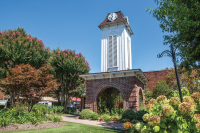The landscapes of our lives
By Michael Beadle
Shafts of sun pierce through a misty forest. A thick river of fog rolls through ancient mountains. Plump sparrows perch on a bare branch thin as tin foil.
These are the images Elizabeth Ellison likes to savor and share. After more than 30 years as a watercolor painter, she knows the best inspiration for painting comes when she’s not thinking about painting.
Maybe it’s a morning walk along a river. Maybe it’s a visit with an old friend. A memory loosens. A feeling stirs. Something emerges and Ellison will carry it back to her downtown Bryson City studio, where wet color and brush and paper tease time into surrendering a vision of a mountain vista, a field of rhododendron, a dense tangle of flaming trees along a river bank.
“When I’m painting, things happen, so I don’t plan for things to happen,” Ellison says.
Related Items
It’s that awareness of intuition and the peace of mind that comes from capturing a moment in nature that have earned Ellison one of the most respected reputations among artists in Western North Carolina. Her work has been sold throughout the United States and Europe, and her paintings and illustrations have appeared in gallery exhibitions and on book covers. She was the watercolorist for “Alice” in the 1999 movie “Songcatcher.”
Ellison recently collaborated with her husband, George, on publishing a new book — Blue Ridge Nature Journal: Reflections on the Appalachian Mountains in Essays and Art. George, a naturalist and long-time newspaper columnist, wrote the essays in the book while Elizabeth provided illustrations and paintings. She even designed the acorn logo for the publisher’s new line of Natural History Press books. The final section of the book includes 40 of her full-color paintings. The project took three and a half months from November of 2005 to February of this year.
The Ellisons have been in Swain County since 1973. The two met as teenagers in George’s hometown of Danville, Va. Elizabeth had grown up 15 miles away, just over the state line in Milton, N.C. Despite their distance apart going to different colleges — George went to UNC-Chapel Hill while Elizabeth attended Averett College in Virginia — they kept in touch.
“His destiny was waiting out there in the country,” Elizabeth says, recalling George as a good-looking football player, a lineman for the Tar Heel team until he got clipped in an Ohio State game that ended his playing career.
Later on after the Ellisons married, George was teaching at Mississippi State University and doing research on Horace Kephart when they decided to move to Western North Carolina. They came with three children, not much money and few job prospects, but a hike through Swain County turned serendipitous when they came across a cabin in the woods four miles outside of Bryson City. The Ellisons would later buy that cabin and its 46 acres on the lower end of Land’s Creek, the last private land before you reach the Great Smoky Mountains National Park. It’s been home for 30 years.
In the Ellisons’ new book, Elizabeth dedicates one of her paintings to Nellie Wiggins, the former owner of the property. In the painting, “Nellie’s Barn” is surrounded by a garland of bright wildflowers.
Today, George writes his columns just down the hall from where Elizabeth paints. Their latest book is the fruit of decades of mutual admiration.
“We’ve always been supportive of each other, believed in each other,” Elizabeth says. “I’d hate to be married to another painter. In the creative world, there’s so much jealousy.”
Teaching tools
When it comes to painting, Elizabeth likes to work from memory rather than from a fixed image like a photograph. And while traditional painters generally paint the background first and finish with the foreground, Ellison will sometimes work backwards, setting up a barn and then filling in what goes around it.
In her studio, you’ll find her on the second floor, surrounded by dozens of canvases. The one propped up in her office in the back is usually the latest one she’s working on. There’s a certain amount of balance required in painting, she explains.
“You should always stop before you think you should stop,” she says.
If Ellison sounds like a teacher, she is. She gives painting workshops at the N.C. Arboretum in Asheville in the spring and fall and has taught at the Appalachian Center for Crafts in Smithville, Tenn.
For beginning painters — and even experienced ones — Ellison likes to emphasize the fundamentals of color and design. Some painters begin by thinking they can mix any colors together and put them anywhere on the paper, but it’s more to it than that. There’s an art to mixing colors, knowing how warm and cool colors will interact.
“When I teach, I try to teach tools,” Ellison says.
While not everyone is born to be a painter, with the right knowledge and work ethic, a student can pick up the techniques to do it right. Ellison found painting in her early 20’s and had enjoyed drawing since she could pick up a pencil. By her college years, she had already begun to develop her own style.
Unlike oil and acrylic painting where the paint is fixed in place by the brush, watercolor painting is a much more fluid process since pigments will move around in the water once they touch the paper. If the paper is too wet, the pigment will disappear and be absorbed into the paper. But if the paper is too dry, the pigment won’t move on the paper.
“You have to get the proportions right,” Ellison explains. “You have to be really gentle with the paper.”
And she even makes her own paper. Over the years, she’s found that yucca and iris leaves are the best to use, but she’s also worked with mulberry, raspberry and cattail leaves.
Painting takes a certain degree of risk and trying out new techniques.
“I don’t think everybody can let that go,” she says.
She keeps a tissue handy to fix painting mistakes since watercolors stain quickly.
“I usually have a paint brush in one hand and a Kleenex in another,” she says.
It’s the process of painting that intrigues her most. Though much of her work is inspired by nature — foggy coves, valleys flush with wildflowers, rocky creek beds, an old barn pressing against a cold sky — Ellison likes to experiment with the colors and faint shapes that give the viewer a new dream to conceive.
These paintings become more than landscapes of the Southern Appalachian mountains. They remind people of their own landscapes, the unspoiled beauty of youth, the trees of childhood and the longing we have to return to such treasured places.
Ellison herself is still very much that kid in the country, growing up around tobacco fields, listening for birds and hiking through the woods.
“It’s really where I come from,” she says.
And with three successful children — Bert, a private contractor in Colorado; Melissa at work on a PhD at the University of Alabama at Birmingham; and Quintin, a reporter with the Asheville Citizen-Times — Elizabeth can be proud of juggling both her family life and her artistry. Having a life where she can live in the country, raise a family and do her art, she has no regrets.
“It’s been kind of an amazing trip,” she says. “Live your days instead of getting through them.”









